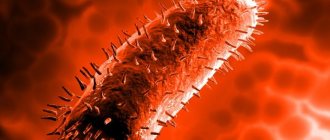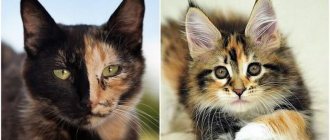Cat purring reduces shortness of breath
Veterinarians conducted a study in which 11 cats and 17 dogs with acute and subacute myocardial necrosis took part. None of the cats had shortness of breath, while all dogs suffered from it.
People who suffer from shortness of breath also notice that it decreases when they pet a purring cat.
Studies have confirmed that the severity of shortness of breath in people with chronic obstructive pulmonary disease is reduced when exposed to sound with a frequency of 100 Hz.
Antennas
If a cat finds itself in a dark and quiet place, it will not be able to navigate using its eyes and ears. In such cases, they use whiskers or, in other words, vibrissae, which act as antennas when orienting themselves in space. A cat's face usually has 12 hard vibrissae on each side. These hairs have a thicker base and their roots are much deeper compared to other hairs. Also, the roots of the vibrissae have a large number of nerve endings, thanks to which cats can easily determine the temperature, wind, and even understand whether it is possible to crawl through the hole.
Hanging out with a cat lowers blood pressure
An experiment was conducted at the State University of New York with the participation of 48 men and women working as brokers. This is known to be a very stressful profession, and all subjects suffered from high blood pressure. All of them were prescribed a drug that lowers blood pressure, and in addition, half of them were prescribed to have a cat at home.
After 6 months, all subjects showed a decrease in average blood pressure, but stress peaks in blood pressure decreased only in those who kept a cat at home. But it is arterial crises that lead to the development of strokes and heart attacks.
Cat treats spine
The cat is able to treat osteochondrosis, radiculitis and other problems with the spine. There is a technique called the cat collar, in which the cat lies on its neck for 3-4 minutes every day, warming up and massaging the cervical vertebrae and muscles. This relieves pinched nerves, relieves headaches caused by osteochondrosis, and eliminates back pain.
Warming plays a primary role here, because the cat’s body temperature is 38.5 degrees. In addition, the cat has an anti-inflammatory and calming effect.
Cats heal fractures and strengthen bones
Researchers from the Institute of Animal Communication in North Carolina (USA) found that frequencies of 20-50 Hz have a strengthening effect on bones. Exposure to this frequency accelerates bone growth and makes them stronger by 20%.
The second most powerful therapeutic effect is the frequency of 100-200 Hz. Experiments showed that the bones of chickens that were on a stand vibrating at this frequency for 20 minutes every day grew faster and were stronger than those of their relatives.
Cats are known to purr when they lick their wounds. This may explain the phenomenal ability of cats to recover from severe injuries. This effect can be used to treat fractures, as well as to prevent and treat osteoporosis in postmenopausal women.
Facts about the senses
A cat's nose print is similar to a human's fingerprint, that is, it is unique for each tailed friend. It is worth noting that a cat’s sense of smell is almost 14 times sharper than that of humans. With the help of its nose, an animal can even discern the temperature of food so as not to get burned.
There is an opinion that cats see their environment in black and white. This is not true at all. They distinguish 6 ranges, and the best color is gray.
Another feature of the eye structure is farsightedness. Sometimes a pet may not see an object that is nearby, but will notice a sparrow on a nearby roof.
The teeth and tongue also serve as sense organs. Cats have 30 permanent teeth. But due to the special structure of the jaw, it is impossible to chew with them.
Cat promotes mental development
In the USA, cats “work” in centers for the treatment of children with autism, delayed neuropsychic development, hypertensive syndrome, Down syndrome, cerebral palsy, etc. Communication with a cat helps the child communicate better with people, develops speech and other communication skills.
Cats help in correcting deprivation disorders in children raised in orphanages.
Cats working in treatment centers undergo strict selection: they must purr willingly, have a good-natured disposition and calm character, and also be happy to make contact with a stranger.
Cats are no less successful in correcting the mental state of adults. Relieves stress, treats depressive disorders, aggression and agitation.
In 2020, humanity first encountered a virus that was destined to cause the first pandemic in a decade and cause significant harm to the economy. However, the world has already repeatedly encountered similar, but to some extent more dangerous, pathogens. They were similar to COVID-19, but did not cause a pandemic, although they found a way to spread across different countries, killing many infected people. "Lenta.ru" talks about two twins - the respiratory coronaviruses SARS and MERS, which became the harbingers of SARS-CoV-2.
Dirty food
Both SARS-CoV-1 and the new SARS-CoV-2 began their journey in game markets, open-air trading areas where wild and domestic animals are sold for human consumption. Exotic animals, including bats, pangolins, snakes and turtles, are used in traditional Chinese cuisine, e-wei. One such market, located in the southern Chinese province of Guangdong, became the birthplace of the SARS (severe acute respiratory syndrome) pathogen in 2002. At that time, humanity was lucky - the coronavirus did not cause a pandemic (partly due to the fact that it was too dangerous for those infected).
Natural carriers of the SARS virus are horseshoe bats that live in the forests of Guangdong. At the market, the coronavirus easily spread to other animals sold nearby, including palm civets. Reproducing inside them, the virus constantly mutated. The appearance of a mutant form capable of infecting people was a matter of time and occurred in November 2002.
Photo: Wikipedia
Any coronavirus, even the most harmless one, targets the mucous membrane of the respiratory tract. It is coronaviruses that cause many respiratory viral diseases that are no stronger than the common cold. However, SARS-CoV-1, which caused a serious outbreak 20 years ago, was different: it affected the human immune system, causing an illness similar to an acute respiratory infection to suddenly turn into deadly pneumonia, in which the lungs filled with fluid, causing respiratory failure. SARS was not like a cold, because it did not cause sneezing and a runny nose, but began with fever, chills and general malaise, and after some time a dry cough appeared.
SARS affected eight thousand people, and almost every tenth died. Among people over 50 years of age, the mortality rate reached more than 50 percent. However, the exceptional danger of the coronavirus played against it: the pathogen killed too quickly and simply did not have time to spread. Since 2004, no cases of SARS-CoV-1 infection have been reported.
Dangerous intermediaries
When it became clear that the Chinese game market was the epicenter of the infection, the authorities tightened trade rules. However, this did not have much effect, because the closed markets soon reappeared. Their semi-legal status made the outlets even more unsanitary. In narrow spaces, inside cages, animals lived side by side with each other, which in the wild never collide with each other. Each of them is a carrier of viruses that can sooner or later overcome the interspecies barrier. The presence of people who come into daily contact with carriers of all kinds of infection only contributes to the emergence of new zoonotic infections.
It was the proximity of bats to palm civets that played a key role in the emergence of SARS. Civet cats were susceptible to bat coronavirus, giving the viruses a reservoir to multiply in numbers. This condition is especially important for the emergence of a mass epidemic. The more viruses, the more mutations and the greater the likelihood that the pathogen will gain the ability to infect a new host - humans. If civets were removed from this fatal chain, the virus would hardly become dangerous to humans.
SARS-CoV-1 Photo: Wikipedia
Zoonotic infections affect only a few people - those who are in direct contact with sick animals. To be transmitted from person to person, additional mutations are needed. But once the virus crosses this threshold, the scale of infections will increase. Therefore, another important factor in the emergence of a dangerous pathogen is prolonged contact of a still harmless virus with people.
The SARS virus is a direct result of human exploration of the wild. It may have existed in bats for centuries or millennia before reaching the Chinese market. As with many other cases of new infections growing in a pandemic, human prejudice played a role. For example, in Chinese traditional medicine, parts and organs of exotic animals are used to prepare medicines for chronic diseases. It is believed that the energy of wild nature passes to humans, providing a healing effect. At the end of the 20th century, the rise of the Chinese economy led to the spread of game markets, which became accessible to the poor. Potentially dangerous viruses circulating in the wild have hit the shelves.
Wave of infection
It is known that the first person to fall ill was a farmer, who soon died in hospital. The spread of the SARS virus around the world began with the Metropole Hotel in the center of the Kowloon Peninsula. A doctor moved in here after contracting the virus while on duty at the hospital where the first patients were admitted. The virus that escaped from his body infected 12 guests who were planning to fly to various countries, including Singapore, Vietnam, Canada, Ireland and the United States. It was then that the disease attracted the attention of the world community, although it was already too late: SARS escaped from China and was subsequently recorded in 32 countries.
Chinese authorities made SARS a state secret, persecuting doctors and journalists who dared to report the disease. Humanity only learned about the spread of SARS thanks to an email from a Guangzhou resident, which mentioned closed hospitals and numerous deaths from an unknown disease. The Chinese authorities tried to obstruct the actions of the WHO, which was trying to find out details about the SARS outbreak. Only when an international organization recommended that travelers not visit the southern regions of China did local officials admit that we were talking about a new dangerous virus, although they lied that the outbreak had been overcome.
SARS was characterized by a phenomenon called superspreading, in which only a small proportion of those infected are responsible for the majority of transmission of the virus. By the end of March 2003, there was an outbreak of SARS among residents of the Amoy Gardens housing complex, and in mid-April there were 321 cases of infection, with 41 percent of those infected living in Block E, and their apartments were located on top of each other.
As it turned out, the spread of the SARS virus was caused by defects in the drainage system of the bathrooms, as a result of which aerosols containing the pathogen leaked into other apartments. Exhaust fans also contributed to this.
Diagram of the spread of the virus in a residential complex Image: Wikipedia
Eastern brother
The causative agent of Middle East respiratory syndrome, which is also a coronavirus, was first isolated in April 2012 by virologist Ali Muhammad Zaki from Saudi Arabia, where the first cases of a disease similar in symptoms to SARS were reported. Zaki, without official permission, sent MERS-CoV samples to world coronavirus expert Ron Fouchier of Erasmus University Rotterdam in the Netherlands, after which European scientists sequenced the genome of the deadly new pathogen and developed methods for diagnosing the disease. Most likely, the virologist’s actions saved hundreds of lives (in total, the virus infected more than a thousand people and killed more than 400), but the angry Saudi authorities did everything to ensure that the scientist subsequently lost his job.
MERS-CoV, like SARS-CoV, originated from a bat virus, but the intermediate host in this case was camels. Humanity was saved from a pandemic by the fact that cases of MERS transmission outside hospitals turned out to be relatively rare (due to the high danger of the pathogen). But unlike SARS, MERS still occurs in the modern world, and there is still no specific treatment or vaccine for the disease. By 2020, there were 2,500 cases of MERS and more than 800 deaths (mortality rate of 34.3 percent).
Both SARS and MERS have similar symptoms. The disease can be asymptomatic or cause extremely severe symptoms - pneumonia, distress syndrome, renal failure, intravascular coagulation and cardiac dysfunction.
Viral rake
One of the many problems associated with the spread of diseases and their transformation into global threats is the failure to notify the world community about the emergence of new viruses in a timely manner and the attempts of countries where outbreaks began to hide important information. This was the case with SARS and MERS, and it has repeated with COVID-19. This time, the disease turned out to be more cunning: by reducing its lethality, the virus was able to cause a full-fledged pandemic, which its more dangerous predecessors could not. The irony is that scientists and doctors have repeatedly warned for years about the high risk of a pandemic from a SARS-like virus. But politicians and the public were not only unprepared for the new virus, but also ignored the problems that the pandemic revealed.
MERS-CoV
Mass diseases have always been accompanied by rumors, prejudices, deliberate misinformation and unfounded fears - experts call this an infodemic. COVID-19 has given modern civilization a unique opportunity to observe its own powerlessness in the face of the pandemic and vulnerability to misconceptions spread through social networks. Covid and other dissidents, as well as anti-vaxxers, play into the hands of viruses, unknowingly making them more dangerous and deadly. When barriers are put in front of a virus, it is forced to adapt, reducing its pathogenicity in order to spread quietly. However, those who are not ready to temporarily change their lifestyle give the green light to deadly viruses.
There is no doubt that COVID-19 will not be the last pandemic. Moreover, there is a high probability that the next pandemic will happen much sooner than many expect. One reason is the destruction of wild ecosystems where pathogens unknown to humans circulate. For now they are harmless, but if people begin to come into contact with them more often, new epidemics cannot be avoided. This is how cholera, Ebola fever, SARS, COVID-19 and many other diseases appeared.
This is the harm of conspiracy theories: instead of paying attention to the environmental side of the problem, people, including politicians and officials, prefer to believe in artificial viruses that escaped from laboratories. Meanwhile, active deforestation continues, including the green areas of the Amazon basin. Perhaps it is from here that a new mass murderer will come, and it seems that humanity will again be unprepared for him.
Cat diagnostics
It has been noticed that many cats are able to accurately identify the owner’s sore spot. And not only what hurts, but also to predict diseases, such as myocardial infarction, epilepsy, malignant neoplasms.
It is believed that cats detect minimal temperature fluctuations (in tissues where inflammation develops, the temperature rises), and also respond to electromagnetic fluctuations emanating from various human organs.
Share this interesting article with your friends, let them know too!
Source
Originally posted 2019-10-18 21:54:01.
Vengeful. If you're offended, you'll shit in your slippers
The mustaches do not shit because they are taking revenge for something, but, on the contrary, they leave their smell. Unneutered cats most often mark their owner's things, showing that this is his territory. Shoes are most often shitted on if the owner has walked down the street and touched a spot marked by another cat. As soon as you enter the house, your pet will immediately smell a foreign smell and begin to “remark.”
The same goes for cats in heat. If you come home with the smell of another walking cat that has rubbed up against you, your kitty will rush to the place where the foreign smell remains. Moreover, it can throw itself quite aggressively.











